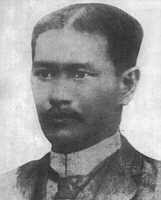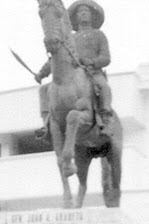A Glimpse of "BUGLAS" the Old Name of Negros Island in the Philippines
Today the 26th of February 2021 is the birth of "GM-BUGLAS" my Personal Digital Node (PDN) to augment and upgrade transceiver activities for enjoyment with fellow duly licensed amateur HAM radio operators worldwide
thru C4FM Philippine Link 43534 - Grupong Magellan (WA6GM/DX1M) headed
by WJ1P (Joel I. Limjoco Pastor of Palos Verdes, CA).
But more
importantly, to serve the people --even in our modest way by coordinating
on the air with front-line rescuers in times of man-made disasters or
natural calamities (God forbid!)
In connection hereof, I wish to express my profound gratitude and sincere appreciation to KJ4CPA (Bong Astorga of
Miami, Florida), N6AKO (Luis Dimagiba of Alerta, CA), and KN6GB (Rod Garcia
of Chula Vista, CA.)
for their untiring
assistance and invaluable support in setting up and in the configuration of my
newly acquired Amateur HAM Radio
Transceiver system. The "return of the comeback" sabi dah! --after my
last sign-off on the air about two and a half scores ago, and in "absentia" for a very long, long while.
Yes! I preferred to use the Node ID GM-BUGLAS to perpetuate the name because my residence back home now is on the island of NEGROS --the sweet spot of the country known in ancient times as "BUGLAS".
Of course, I shall be monitoring on the airwaves with the same
PDN while in my home-base in sunny SanDie Californy --73 de N6MRD (Dinggol)
Related article:
THE "NEGRENSES"
(By DinggolAranetaDivinagracia * N6MRD- Dinggol)
Prologue: "Negrense"
is the term used to distinguish a native "tumandok" or original inhabitant of
Negros Island in the Philippines, which became even more popular only during the tenure of
Governor Daniel "Bitay" Lacson because national and local media and all
government agencies aggressively promoted it.” ~~~
However, in most part of Negros Occidental, they still prefer to be called simply “Ilonggos”, until today. While those in the Negros Oriental area are often called Cebuano’s, because of their common language and geographical proximity to the island of Cebu.
The whole Negros island was formerly called "Buglas", an Aeta word which means "sudden cut-off" and in Hiligaynon or in the Ilonggo language it means "Buklas".
These Aeta’s, Eta's, Agta’s, or Ati's are short dark-skinned nomads
with woolly kinky hair are the aborigines of the archipelago.
The
Maragtas legend explained and the ancient Chinese Ming Dynasty Chronicle
confirmed that the ten (10) noble-bearing Malay Datus from Bornay
(Borneo), led by Shri Vijaya Sultanate Minister Datu Putih bartered
their gold and jewelry with local Ati Chieftain Marikudo for the
lowlands, plains, and valleys of the island they called “Aninipay".The Malay settlers later renamed the area as Madja-as or paradise and they likewise, called the island “Panai” after their place of origin near Lake Toba in the middle of the Indonesian Islands of Sumatra along the Malacca Strait in the Malay Peninsula -- before they were forced to sail and to settle for some time at Kinabatangan in North Borneo. Today, we call the whole island “Panay”.
After the barter trade, Ati Chieftain Marikudo and his wife named Maniwang-tiwang together with their family and most of their tribesmen, resettled in the hinterlands and up to the high mountains of the island where they lived peacefully and undisturbed for many, many centuries. While the other Aetas sailed to "Buglas" passing "Himal-os" now Guimaras Island where some stayed behind near the area of "Bundolan" later called as Bala-an Bukid.
It was the Spaniard who gave the Buglas island its present name "NEGROS" due to the predominant presence of these small group of people they called Negroes or "Negritos".
Two great waves of migration resulted in the gradual near extinction of this ancient (Filipino) ethnic group due to inter-relationship and marriages with outsiders.
During
the middle part of the 1800s, many families joined the exodus of the
more adventurous members of prominent Ilonggos from the City of Iloilo,
such as; the Yulo's and the Yusay's, the Lacson's and the Locsin's, the
Lopez's and the Ledesma's, the Montinola's, Montilla's and
Montelibano's, the Villanueva's and Valencia's, the Jalandoni's and
the Javellana's, the Araneta's, Benedicto’s, Magalona’s, Salas's, and de
la Rama's and others; who brought along their own families,
households and subordinates immigrated to the "New Frontier", the
island of Negros, that eventually became known as the land of "Sugar
Barons" or Sugarlandia, "sa diin ang kuarta gina piko kag gina pala". Kuno!
When
the sugar industry started to boom, the demand for tens of thousands of
sugar plantation workers were filled by the industrious and indigenous
Ilonggos of Northwestern Aklan and Antique including the lowly Aetas.
A
great number of these migratory sugar plantation workers known as
"Sacadas" had ultimately decided to stay and settle permanently in
different parts of Negros island and naturally multiplied.
Therefore, it is safe to conclude that "Negrenses" are G.I's or truly Genuine Ilonggos.
Epilogue:
The Negritos of today still retain the "Inati" language used by their forefathers for many centuries, and refer to their brown brothers in the lowlands as "Mga Bisaya". A glaring and clear manifestation of the historical encounter between the aboriginal Aetas and the Shri Visayans as contained in the "Maragtas" ---a myth that became a legend, and the legend that turns out to be the true history of the proud and noble people of the once-upon-a-time great "Ilonggo Nation". ~~~
Acknowledgment:
1) A rare photo on a clear day of Mount Kanlaon in Negros island, with Guimaras island as viewed from Iloilo City in Panay island. (courtesy of Edgar H. Siscar).
2) The Malay landing and "Hinilawod" in the photo are oil on canvas paintings of famed Ilonggo Artist Art Geroche.
3) The main source re: “Panai” - Fr. Francisco Colin, S.J. (1592-1660) in his 1600s work, "The Evangelical Work of the Society of Jesus."
(Photos for illustration only)
~~~~~~~~~~ oo0oo ~~~~~~~~~~


















No comments:
Post a Comment